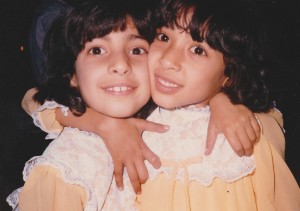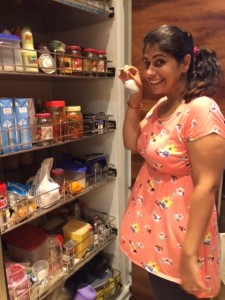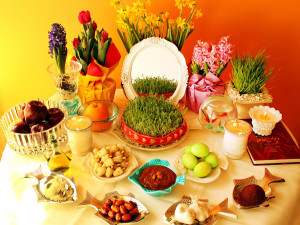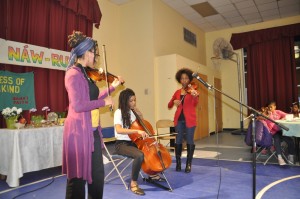This post originally appeared on Murder Is Everywhere.

A few decades ago, when I was on a father-daughter trip to India, I came fact to face with my future.
Not my sweet husband (although plenty of people I met on that trip offered to find me one).
That fateful evening in March, 1989, I suddenly found myself in the midst of a party celebrating Navroze, or the Persian New Year, a major spiritual and social occurrence based on the spring equinox. Nowrooz, Navroz, Navroze, Naw-Ruz, Nowroz, and several other spellings all mean “New Day” in Persian. This is the date that changes slightly every year: when the length of sunlight equals night.
It is the start of the lunar calendar calculated by Persians about three thousand years ago. In those days, the state religion was Zoroastrianism. However, it seems that anyone whose ancestors spent time in Iran, whether Zoroastrian, Muslim, Baha’i or Kurdish, observes this new year. Some communities celebrate three days…others almost two weeks.
I knew none of this going in. That long ago evening at the India International Centre in New Delhi. I was strolling about, killing time until the dining hall opened and my father and I could get something to eat. I drew near a splendidly decorated pavilion.

I felt I were gazing into a magic world. Darling little girls wore white lace frocks, ladies were draped in luxurious saris and all the gentlemen were clad traditional white suits with unusual headgear (Later I learned these were lacquered turbans called fetahs). I admired the scene until a kindly elder insisted I join them. I had my first rapturous taste of spicy, sophisticated Parsi food (Parsi transliterates to “Persian” and refers to the Zoroastrian immigrants who arrived in Gujarat starting in 600 AD).
My first taste of Parsi hospitality must have been auspicious, because many years later, I find myself revisiting the March New Year in fictional form. I’m currently writing a novel starring a Zoroastrian family in 1920s Bombay. Just last week I was writing about the rigorous house cleaning that before the New Year. There’s a lot to it!

My friend Perzen Patel, aka the Bawi Bride, is a Parsi caterer and food blogger in Mumbai. For Perzen, the Persian New Year means a lot of family visiting and a tremendous amount of cooking for friends and customers. Several weeks before the holiday, she sent this enticing email to her friends and blog followers, and customers.
This year to bring in Navroze I thought we’d go the extra mile and really create a menu that is beyond the ordinary. So, I’ve put my thinking cap on and planned a lovely special that you can avail any day from Saturday 19 – Monday 21 March.
Our menu is as follows:
- Kheema Pattice—savory mashed potato and lamb patties
- Badam Malai Chicken Pulao—a savory rice pilaf studded with chicken cooked in cream with almonds
- Masala ni Dar—spicy lentils
- Kid Gosht—lamb curry
- Patra ma Prawns—prawns steam-cooked in banana leaves
- Lagan nu Custard—sweet baked pudding garnished with raisins and cashews
All of this yummy food for the special price of ₹1550 per plate including delivery with each plate as a whole enough for two people.
Translation: that’s about $25 for a New Year’s feast for two! If you’re curious, try Perzen’s custard recipe highlighted above or the many delicious home recipes on the Bawi Bride website.

Perzen says that if the celebratory Navroze meal is home-cooked (which is typical), at least one fish dish would be included for good luck. There might also be a nougat sweet, Gaz, imported from Iran. Perzen’s favorite non-culinary part of the holiday is the Haft Seen table laid out with seven lucky edibles that start with the “S” sound in Persian. These range from sumac to apple and garlic and herbs. A key item on the table is the mirror, placed there so visiting relatives can look into it and reflect on their past year and any blessings.

A Baltimore friend, Sheila Mohajer Hofert, is a Baha’i who fled Iran with her family in the early 1980s. The Baha’i start their New Year at approximately the same time as Zoroastrians and Iranian-origin Muslims. One difference is the Baha’i fast from sunrise to sunset for the last 19 days before Naw-Ruz. Sheila says the fasting makes one “more understanding of the people who are hungry in the world—and to become more aware of our bodies and our emotions. For example, working on treating others kindly when you personally don’t feel very well.”
This year, on March 19, more than 200 Baha’is and their friends gathered to enjoy food, song, and prayers.
I also asked Sheila her favorite aspect of Naw-Ruz. She wrote: “As winter gradually fades away and the paleness of the world is replaced with fresh colors and fragrance, it brings with the promise of the new day. It remind me of he cyclic nature of our universe and the cyclic nature of our lives, which are constantly filled with crises, followed by victory.”

Life will always get better. Naw-Ruz Mubarak!
